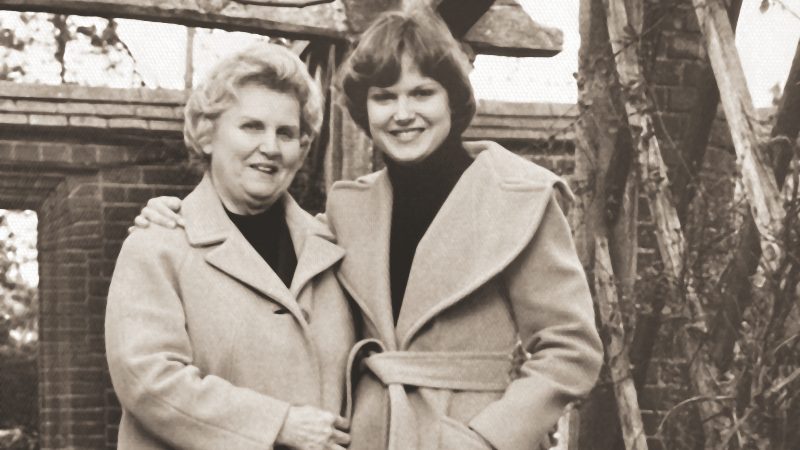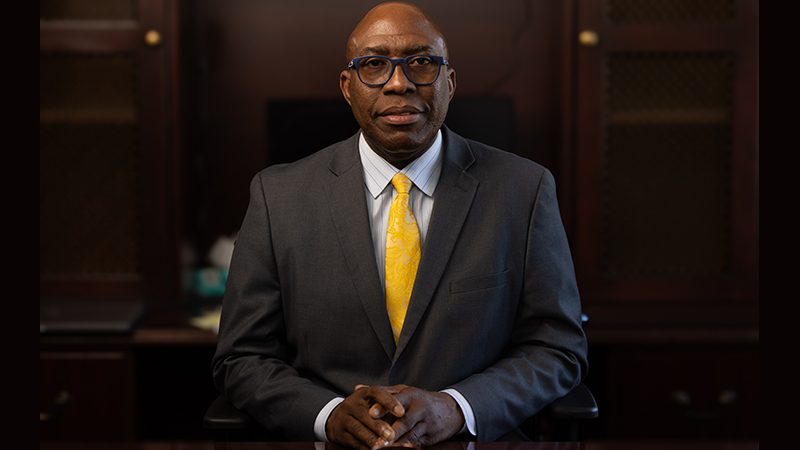As she and her dad traveled in the old blue Nissan sedan along Michigan State Highway 46, Sandra Roberts was trying to imagine what lay ahead. It was the late summer of 1980. She was to assume work as the assistant girls’ dean at Cedar Lake Academy (now Great Lakes Adventist Academy).
Roberts had recently completed a bachelor’s degree in clinical dietetics at Loma Linda University. And now she was to be paid very little for the long hours demanded of a dean in a dormitory filled with more than a hundred high school girls. She was to be known as a Taskforce volunteer. She would have a room in the dormitory, she would eat in the cafeteria, and she would receive a small monthly stipend that might cover her basic needs.
As it turned out, Roberts spent two years living, working, laughing, and shedding more than a few tears with those high school girls. Then she took another position as a Taskforce volunteer.
This time, already sensing a call to ministry, Roberts took a job working in the Youth Department of the Pacific Union Conference office. Although it was another position involving little pay for a lot of work, Roberts thought it could be a good career move. “I felt like there was a lot of opportunity for women in church youth ministry at that time,” she recently recalled during a telephone conversation.
Pacific Union Youth Director Dan Savino was responsible for, among many other tasks, the “call book” that went to Adventist colleges describing each of the opportunities for yearlong volunteer service as foreign student missionaries and, in North America, as Taskforce volunteers. Assembling the call book became Roberts’ responsibility. In this role, she would work with the North American Division, the General Conference, and Adventist colleges in putting the call book together.
As she carried out her work, Roberts gained the confidence of North American Division Youth Director Les Pitton, who urged Roberts to pursue a master’s degree at the Theological Seminary at Andrews University. Pitton arranged the sponsorship that would fund her pursuit of the degree.
In 1984, after completing the seminary degree, Roberts finally took an actual salaried position, teaching Bible at Modesto Adventist Academy. Following two years in Modesto, she moved back to Southern California and in the following years served as facilities director at Pine Springs Ranch, campus chaplain at Loma Linda Adventist Academy, and associate pastor at the Corona church.
Moving to the Southeastern California Conference office, Roberts served as youth director, executive secretary, and then, for eight years, as conference president. She now serves as executive secretary of the Pacific Union Conference.
Thinking back over her varied opportunities for ministry, Roberts recently reflected, “The Taskforce program helped me find a pathway into ministry as a young woman. Women in ministry were fairly rare in those days, and Taskforce provided a lot of us with incredible opportunities to be mentored and to do things in ministry that we would otherwise never have been able to do. The church has been better for it.”
Where it began
The Taskforce program, at first termed Domestic Student Missions, began 50 years ago. Let me describe a personal experience that occurred very close to that beginning.
I was in my dorm room in Grainger Hall at Pacific Union College (PUC). It was the spring of 1973. My friend Ray wandered across the hallway from his room to mine. I think our conversation must’ve gone something like this:
“So, Bert, remind me what you and Donna are planning for the date of your wedding.”
“It’ll be sometime in August. We haven’t settled on which weekend.”
“Well, I think you may need to move it up to June.”
“June? What? Why?”
“Well, I’m thinking that by sometime in July you and Donna may be up in British Columbia.”
“No, no such honeymoon plans. We’ll barely afford three days in Yosemite.”
“I’m not talking about your honeymoon.”
“OK?”
“So here’s the deal. I have a cousin who is the youth director for the British Columbia Conference. He and I have been talking about an idea, and he has been talking to people he knows in this town of Williams Lake. There’s a large Adventist church. An Adventist family owns a large sawmill. Lots of young families are church members, and there are a lot of young single guys with Adventist connections who work in the mill. There’s a 10-grade Adventist school. Anyhow, my cousin Bob Tetz used to be the pastor of this church, and he has been talking to some of the members about the possibility of the church supporting a youth pastor. I told Bob I know somebody for the job.”
“OK?”
“So, that’s you and Donna.”
This conversation with Ray Tetz contained the seed of an idea that grew to be known as Taskforce.
The Student Missions program had been going strong for years, sending Adventist college students abroad for a year of volunteer service. However, taking a full year away from college classes to volunteer for service in North America was, well, a foreign idea.
Ice skates and snowmobiles

So, these two kids from the San Joaquin Valley, Bert Williams and Donna Brown, got married on June 9, 1973, drove north in their Ford Courier pickup, and spent the next year in a spot where, when winter arrived, the thermometer would sometimes dip to 40 degrees below zero.


We planned Saturday night youth activities, sometimes on ice skates and toboggans. We led worship at the school, planned youth Sabbath School programs, and took groups to lead Sabbath afternoon neighborhood Branch Sabbath Schools. During the week, I frequented Jacobson Brothers Forest Products, Ltd., visiting with young men who were operating hydraulic log sorters, driving forklifts, and loading lumber into box cars.
The pastor assigned me to preach periodically, and throughout that year I led a weekly after-school Bible study group with teenagers from the local public high school. One of those young people was baptized in the Williams Lake church near the end of that school year. He attended PUC beginning the following school year and recently completed a 40-year career teaching in Adventist schools.
PUC students energize growth
During that ’73-’74 school year, efforts continued back at PUC to grow the Taskforce program. Ray Tetz, who was Student Association religious vice president that school year, Campus Chaplain Ted Wick, and others worked to line up several couples to fill calls for the ’74-’75 school year. Eight students did go as Taskforce volunteers from PUC that year: Ray and Rosy Tetz, Barry and Bonnie Casey, and Brent and Glenda Carlson—all to British Columbia—and Thure and Pat Martinsen to Salt Lake City.
Back at PUC during that ’74-’75 year, I was asked to head up recruitment for the ’75-’76 school year. Dick Duerksen was the staff sponsor for the Taskforce recruitment effort on campus. A group of student volunteers doing on-campus promotion and staffing screening committees filled nearly 40 calls for Taskforce volunteers for the ’75-’76 school year. These PUC students served as boarding academy dormitory assistant deans, as staff members in church-operated daycare centers, as youth pastors, and in various other projects.
Taskforce proved to be an idea whose time had come. It quickly spread out to other North American college campuses and to Adventist churches and schools across the continent.
To be Continued ...
_____________________________
Bert Williams, former editorial director at Christian Record Services for the Blind, writes from San Mateo, California.
Una idea a la que le llegó su tiempo - 1ª Parte
Por Bert Williams
Mientras ella y su padre viajaban en el viejo sedán Nissan azul por la autopista estatal 46 de Michigan, Sandra Roberts intentaba imaginar lo que le esperaba. Era finales del verano de 1980. Iba a asumir el cargo de preceptora asociada de niñas en la Cedar Lake Academy (ahora Great Lakes Adventist Academy).
Roberts había completado recientemente una licenciatura en dietética clínica en Loma Linda University. Y ahora se le iba a pagar muy poco por las largas horas que se le exigían a una preceptora en un dormitorio con más de cien chicas de high school. Iba a ser conocida como voluntaria de Taskforce. Tendría una habitación en el dormitorio, comería en la cafetería y recibiría un pequeño estipendio mensual que podría cubrir sus necesidades básicas.
Resultó que Roberts pasó dos años viviendo, trabajando, riendo y derramando más de unas pocas lágrimas con esas chicas. Tomó después otro puesto como voluntaria de Taskforce.
Esa vez, ya sintiendo un llamado al ministerio, Roberts aceptó un trabajo en el Departamento de Jóvenes de la oficina de la Pacific Union Conference. Aunque era otro puesto que implicaba poco pago por mucho trabajo, Roberts pensó que podría ser un buen paso en su carrera. «Sentí que había muchas oportunidades para las mujeres en el ministerio juvenil de la iglesia en ese momento», recordó recientemente durante una conversación telefónica.
El director de jóvenes de la Pacific Union, Dan Savino, era responsable, entre muchas otras tareas, del «libro de llamados» que se enviaba a las universidades adventistas en el que se describía cada una de las oportunidades de servicio voluntario de un año como misioneros estudiantes extranjeros y, en América del Norte, como voluntarios de Taskforce. Armar el libro de llamados se convirtió en la responsabilidad de Roberts. En ese cargo, trabajaría con la División Norteamericana, la Conferencia General y las universidades y colleges adventistas en la elaboración del libro de llamados.
A medida que llevaba a cabo su trabajo, Roberts se ganó la confianza del Director de Jóvenes de la División Norteamericana, Les Pitton, quien instó a Roberts a obtener una maestría en el Seminario Teológico de Andrews University. Pitton organizó el patrocinio que financiaría su búsqueda del título.
En 1984, después de completar su título en el seminario, Roberts finalmente tomó un puesto asalariado, enseñando Biblia en la Modesto Adventist Academy. Después de dos años en Modesto, regresó al sur de California y en los años siguientes sirvió como directora de instalaciones en Pine Springs Ranch, capellán del campus de la Loma Linda Adventist Academy y pastora asociada en la iglesia de Corona.
Al trasladarse a la oficina de la Southeastern California Conference, Roberts se desempeñó como directora de jóvenes, secretaria ejecutiva y después, durante ocho años, como presidente de la conferencia. Ahora se desempeña como secretaria ejecutiva de la Pacific Union Conference.
Pensando en sus variadas oportunidades en el ministerio, Roberts reflexionó recientemente: «El programa de Taskforce me ayudó a encontrar un camino hacia el ministerio cuando era joven. Las mujeres en el ministerio eran bastante raras en esos días y Taskforce nos brindó a muchas oportunidades increíbles para ser asesoradas y hacer cosas en el ministerio que de otra manera nunca hubiéramos podido hacer. La iglesia ha sido bendecida por eso».
Donde empezó
El programa de Taskforce, que al principio se denominó Domestic Student Missions, comenzó hace 50 años. Permítanme describir una experiencia personal que ocurrió muy cerca de ese comienzo.
Estaba en mi dormitorio en Grainger Hall en Pacific Union College (PUC). Era la primavera de 1973. Mi amigo Ray deambuló por el pasillo de su habitación a la mía. Creo que nuestra conversación debe haber sido más o menos así:
«Así que, Bert, recuérdame lo que tú y Donna están planeando para la fecha de su boda».
«Será en algún momento de agosto. No hemos decidido cual fin de semana».
«Bueno, creo que es posible que debas adelantarlo a junio».
«¿Junio? ¿Qué? ¿Por qué?»
«Bueno, creo que en algún momento de julio tú y Donna estarán en British Columbia».
«No, no tenemos planes de luna de miel. Apenas nos permitiremos tres días en Yosemite».
«No estoy hablando de tu luna de miel».
«¿Entonces?
«Este es el trato. Tengo un primo que es el director de jóvenes de la British Columbia Conference. Él y yo hemos estado hablando de una idea y él ha estado hablando con gente que conoce en la ciudad de Williams Lake. Hay una gran iglesia adventista. Una familia adventista es dueña de un gran aserradero. Muchas familias jóvenes son miembros de la iglesia y hay muchos jóvenes solteros con conexiones adventistas que trabajan en la fábrica. Hay una escuela adventista de 10 grados. En fin, mi primo Bob Tetz solía ser el pastor de esa iglesia y ha estado hablando con algunos de los miembros sobre la posibilidad de que la iglesia apoye a un pastor de jóvenes. Le dije a Bob que conozco a alguien para ese puesto».
«¿Qué tengo yo que ver?
«Me refería a ti y a Donna».
Esa conversación con Ray Tetz contenía la semilla de una idea que se conoció como Taskforce.
El programa de Misiones Estudiantiles había estado funcionando durante años, enviando a estudiantes universitarios adventistas al extranjero para un año de servicio voluntario. Sin embargo, tomar un año completo fuera de las clases universitarias para ofrecerse como voluntario para el servicio en América del Norte era, ciertamente, una idea extraña.
Patines de hielo y motos de nieve

Así que, esos dos hijos del Valle de San Joaquín, Bert Williams y Donna Brown, se casaron el 9 de junio de 1973, condujeron hacia el norte en su camioneta Ford Courier y pasaron el año siguiente en un lugar donde, cuando llegaba el invierno, el termómetro a veces bajaba a 40 grados bajo cero.


Planeamos actividades juveniles los sábados por la noche, a veces en patines de hielo y toboganes. Dirigíamos el culto en la escuela, planificamos los programas de Escuela Sabática para jóvenes y tomamos grupos para dirigir Escuelas Sabáticas filiales del vecindario el sábado por la tarde. Durante la semana, frecuentábamos Jacobson Brothers Forest Products, Ltd., visitando a jóvenes que operaban clasificadoras hidráulicas de troncos, conducían montacargas y cargaban madera en vagones.
El pastor me asignó a predicar periódicamente y a lo largo de ese año dirigí un grupo semanal de estudio bíblico después de la escuela con adolescentes de la high school pública. Uno de esos jóvenes se bautizó en la iglesia de Williams Lake cerca del final de ese año escolar. Asistió a PUC a partir del siguiente año escolar y recientemente completó una carrera de 40 años enseñando en escuelas adventistas.
Estudiantes de PUC dinamizan el crecimiento
Durante ese año escolar ’73-’74, los esfuerzos continuaron en PUC para hacer crecer el programa Taskforce. Ray Tetz, quien era vicepresidente religioso de la Asociación de Estudiantes ese año escolar, el capellán del campus Ted Wick y otros trabajaron para alinear a varias parejas para llenar las vacantes para el año escolar ’74-’75. Ocho estudiantes fueron como voluntarios de Taskforce de PUC ese año: Ray y Rosy Tetz, Barry y Bonnie Casey, y Brent y Glenda Carlson, todos a British Columbia, y Thure y Pat Martinsen a Salt Lake City.
De vuelta en PUC durante ese año ’74-’75, me pidieron que dirigiera el reclutamiento para el año escolar ’75-’76. Dick Duerksen fue el patrocinador del personal para el esfuerzo de reclutamiento de Taskforce en el campus. Un grupo de estudiantes voluntarios que realizaron la promoción en el campus y los comités de selección de personal llenaron casi 40 llamados para voluntarios de Taskforce para el año escolar ’75-’76. Esos estudiantes de PUC sirvieron como preceptores asistentes de dormitorios de academias con internado, como miembros del personal en guarderías operadas por la iglesia, como pastores de jóvenes y en varios otros proyectos.
Taskforce resultó ser una idea a la que le había llegado su momento. Rápidamente se extendió a otros campus universitarios de América del Norte y a iglesias y escuelas adventistas en todo el continente.
Continuará...
_____________________________
Bert Williams, exdirector editorial de Christian Record Services for the Blind, escribe desde San Mateo, California.






